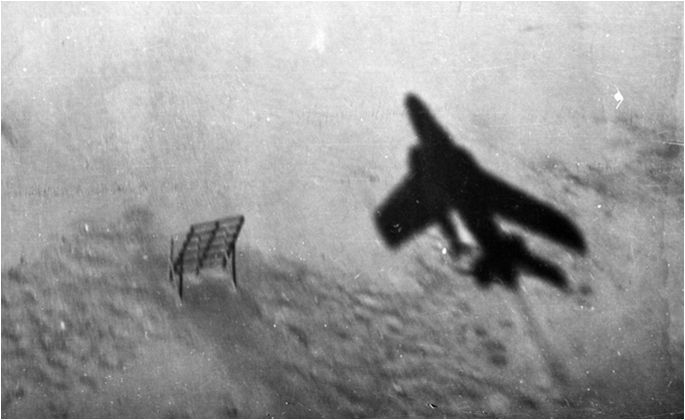
Operation MUSKETEER was a British-French-Israeli plan to capture the Suez Canal in November 1956, following its nationalisation by the Egyptian leader, President Nasser. An attack on Egypt by Israel was designed to be the justification for British and French forces to act to secure the safety of the canal. While the operation was a military success, it was a Cold War political disaster for the UK and France, leading to their isolation from their western allies, especially the USA, and encouraging Egypt and other Arab states to cultivate closer relations with the Soviet Union.
The images featured here are a selection of those taken by the French Air Force reconnaissance unit 4/33, which flew the RF-84F Thunderflash aircraft from British bases in Cyprus during the Suez Crisis. These aircraft brought back low-level tactical reconnaissance photographs which enabled British and French photo-interpreters to assess the damage inflicted on Egyptian airfields by Royal Air Force bombers, and to report on the position and strength of Egyptian defences in the Port Said and Port Fuad areas, which had been chosen as sites for airborne and amphibious assaults.
Phase one: Air attack
| During the first phase of the operation, beginning on 31 October 1956, British and French aircraft attacked Egyptian airfields in an attempt to neutralise the Egyptian Air Force. This image shows three bomb craters between buildings at Fayed airfield. The Egyptians lost around 260 aircraft during 5 days of bombing and retreated to airfields further south and in neighbouring countries. |
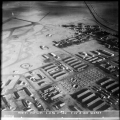 |
| Another view of Fayed airfield, showing bomb damage to hangars, accommodation blocks and runways. At least 4 Vampire fighter-bombers are visible parked on the apron at photo centre. |
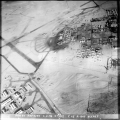 |
| This image of the airfield at Cairo West shows bomb damage to runways, hangars and parked aircraft. Three Egyptian Air Force Vampire fighter-bombers are visible, parked north-east of a destroyed aircraft hangar, while five Lancaster bombers on a parking apron to the east can be seen to have been heavily damaged. |
 |
| A French RF-84F Thunderflash aircraft photographed its own shadow during this low-level run over an Egyptian military camp on 4 November 1956. The jet's exhaust efflux is revealed by its shadow, along with that of a drop-tank under the port wing. This sortie was flown the day before parachute landings at Port Said and Port Fuad, 26 miles to the north, and was probably flown to discover the state of readiness of Egyptian forces. |
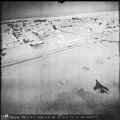 |
Phase two: Airborne and amphibious assaults
| French photographic interpreters have annotated this image from 2 November 1956 with the locations of two coastal defence guns and two possible tanks, to the east of Port Fuad. The identification of such positions was vital to the French, who were planning to drop airborne troops into the area behind these guns on 5 November 1956 and make an amphibious assault on this shoreline the following day. |
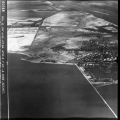 |
| El Gamil airfield to the west of Port Said was the target of a British airborne assault by the 3rd Battalion, The Parachute Regiment, soon after dawn on 5 November 1956. The drop was a complete success and the airfield was secured within 45 minutes, allowing reinforcements and supplies to be dropped in a second lift. |
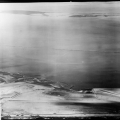 |
| After seizing the airfield, British paratroops began to move east, towards Port Said, along a narrow isthmus of land between the sea and Lake El Manzala. They encountered resistance to their advance at this sewage treatment plant, where fierce fighting ensued and was overcome with air support from the Fleet Air Arm. A ditch across this narrow strip of land, dug to control vehicle movement, is visible at lower left. |
 |
|
On the following day, 6 November 1956, Royal Marines of 45 Commando were airlifted to this area by helicopter to secure the docks. More troops were to be landed by ship but the docks were found to be blocked by sunken vessels, such as that visible in mid-channel.
A statue of Ferdinand de Lesseps, the French designer of the Suez Canal, is visible in the foreground, at the south-eastern corner of the docks. The statue was viewed as a symbol of colonialism by the Egyptians, who removed it when they re-entered the area following the ceasefire.
|
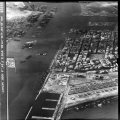 |
| During the amphibious assault on 6 November 1956, Royal Marines of 40 and 42 Commando's landed on this beach at Port Said after an initial bombardment by ships and aircraft. By late afternoon, the town had been secured and by midnight Anglo-French forces had reached El Cap, some 23 miles to the south. |
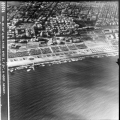 |
Ceasefire
|
The advance was short-lived, however, as a ceasefire was called at the insistence of the United Nations at midnight on 6 November. Under severe pressure from the United States, and facing the threat of military intervention by the Soviet Union, Britain and France removed their troops over the following weeks. This image shows French Panhard EBR armoured reconnaissance vehicles and supplies being collected for loading onto support ships at Port Fuad on 17 November 1956.
In January 1957, British Prime Minister Anthony Eden resigned.
|
 |












